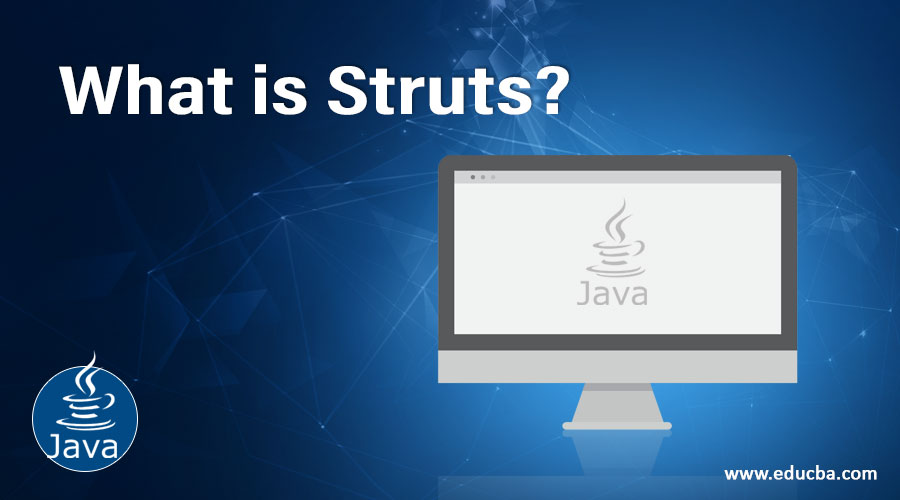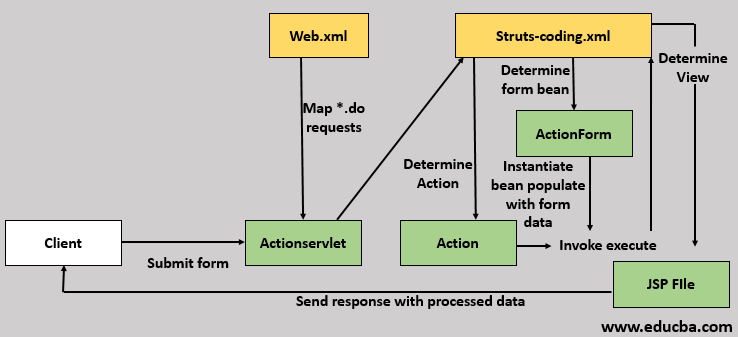Updated March 20, 2023
Introduction to Struts
Struts are one of the many frameworks that are used for website or web-based application development using Java application program interface (API). This framework helps create a web-based application by generating the business logic provided by the client, using the file containing the properties of the application objects and related data. It is renowned for its characteristics associated with security and integration options and can be used to implement applications of any scope.
What are Struts?
Below are the points that explain what is Struts in detail:
- The model is separated from the view and controller. Model is the application logic to interact with the database, and View is the HTML page viewed by the client.
- A controller servlet called Action Servlet is used when the framework is started.
- The templates are written using JSP for the HTML content.
- The programmer creates the configuration file called struts-config.xml.
- This servlet maps requests to Struts Action objects using struts-config.xml.
- If any information has to be changed, updation in the XML file should be more than enough.
- Action form objects are created to temporarily store data, and the requests are executed.
- The model returns a string (Action forward) to instruct the controller to send the client’s output page.
- Once the requests are processed, the Action object processes new data, and results are forwarded to the appropriate view.
- The model and client pass information using a form called JavaBeans.
- A custom tag library is used to read and write the content of the beans, and hence Java code is not needed.
- Webforms are internationalized using Struts, and templates are created for the presentation layer. The template mechanism is called Tiles.
- The applications can be integrated with any other framework or application.
- UI tags, control tags, and action tags are provided so that struts are easy to use.
- XHTML, CSS_HTML and simple are the themes of struts where XHTML is the default theme.
- Threads are created to handle requests in servlet technology, and hence separate memory areas are not created.
- The presentation layer is mixed up with business logic, and the servlet needs to be recompiled if there is any code change.
- It is pretty easy and fast to develop web applications.
- Maintenance was a concern as the pages were decentralized, and logic has to be determined to write the subsequent pages.
Why are Struts Used?
Below are the points that explain why we use Struts in detail:
- The developer has to write only business logic. The Struts framework takes care of the web application.
- The model creates business domain knowledge while View displays the presentation layer to the client. A controller controls the user input to the application.
- The web container hosts the web application, and requests are handled easily using the same. Hence developers need not worry about the same and can focus on building applications.
- The application does not need any coding as the properties files store all the data.
- The changes have to be enhanced in the properties files, and it reflects in the application.
- Troubleshooting is done easily, and the application solves the errors fast to create JSPs.
- The tags, resources, classes, and servlets are combined together, and hence the result is always in a synergistic format.
- The modules in the framework help to import and do the work with very little coding.
- The database values are converted to objects and vice-versa, which helps in the easy communication of Java as an object-oriented language.
- Validation is done automatically, and file upload and download are carried out easily using the Action servlet.
- Security and database integrity is more in Struts which makes the developers use this application more often.
- The applications are extended or modified easily without any change in the business logic.
- The new class and the features are added automatically in the XML file, and hence time is saved for the developers.
- The separate module to handle the images is a standalone module that functions efficiently.
- The application of any size can be developed in this framework.
Framework
Below are the framework of Struts you should know about it:
- The framework creates the application completely from components, validators, error handling, and many other processes. The framework models the application views it through the clients’ eyes and controls the application to serve the purpose of the same. The controller component is responsible for the integration of Model and View formats. Many presentation technologies such as JSP, JSF, JSTL and velocity templates are integrated into the view or presentation layer. In the model layer, data access technologies such as JDBC, Hibernate and EJB work well.
- The architecture is more reliable and robust, and hence developers prefer the usage more. The application is scalable, and the design is easy for any beginners. The development time for the application is reduced as the time for the application to develop is less as there are inbuilt modules.
- The framework’s main components are a request handler, a response handler, and a tag library. Standard URI maps the Request handler that application developers provide. The control is transferred to another resource that completes the response in the response handler. Interactive form-based applications with server pages are created using the tag library.
- The main goal is to extend the Java API and MVC framework in the application. The space to download or use the framework is more as it is not lightweight. The technologies are integrated well with the application, but coding is not done automatically in the framework. Struts use action mappings and do not have handler mappings. The separation is not evident or clear in the application as there are no different layers. The classes are configured well in the framework, and hence manual intervention is not needed in the application.
- Struts are a large framework and hence used to create enterprise-wide applications. The design, action form, and annotations are simple and easy to understand. Whenever the requests are made, actions are created, and the servlet response to the model call. The client is free to select any framework based on the need and knowledge of the application.
Recommended Articles
This is a guide to What is Struts?. Here we discuss an introduction to Struts, What is Struts, why to use and the framework of struts. You can also go through our other related articles to learn more –



